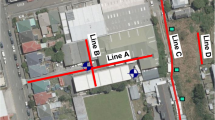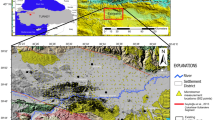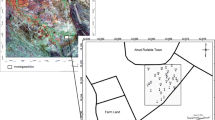Abstract
The main objective of this study was to propose an approach to estimate the peak friction angles of over-consolidated granular soil deposits by using the P-wave velocity and the SV- and SH-wave velocities. To this end, seventeen pairs of P- and S-wave seismic refraction profiles were carried out at three different granular sites in Iran using noninvasive seismic wave methods. To estimate the overconsolidation ratio (OCR) in granular geomaterials in terms of SH/SV velocity ratios, a general regression analysis was performed on the obtained data from this study combined with those reported in the literature. In addition, by assuming cross-anisotropy of the soils, the P- and S-wave velocities were utilized to develop an equation for calculating the coefficient of lateral earth pressure at rest (K0). The Mayne and Kulhawy formula was finally employed to evaluate \(\varphi^{\prime}\) in granular soil deposits by combining the calculated K0 values and the estimated OCR values. The findings of this study may be used as the appropriate approaches for economic and noninvasive determination of in-situ peak friction angle in granular soil deposits using the surface seismic surveying.








Similar content being viewed by others
References
Abelev AV, Gutta SK, Lade PV, Yamamuro JA (2007) Modeling cross anisotropy in granular materials. J Eng Mech 133(8):919–932
Allue JO, Pulgar JA, Viejo GF, Cortina JMG (2008) Geotechnical site characterization of a flood plain by refraction microtremor and seismic refraction methods. In: 21st symposium on the application of geophysics to engineering and environmental problems (SAGEEP), pp 437–445. https://doi.org/10.4133/1.2963283
ASTM D7015/7015M-18 (2018) Standard practices for obtaining intact block (cubical and cylindrical) samples of soils. ASTM International, West Conshohocken, PA. www.astm.org. https://doi.org/10.1520/d7015-d7015m-18
Atre SR, Carpenter PJ (2010) Identification of cross-valley faults in the Maynardville Limestone, Oak Ridge Reservation, Tennessee, using seismic refraction tomography. Environ Earth Sci 60:1245–1256
Bery AA (2013) High resolution in seismic refraction tomography for environmental study. Int J Geosci 4:792–796
Capar OF, Ishibashi I (2010) Recovery of elastic parameters fpr cross-anisotropic sandy soil via elastic wave measurements. In: Proceedings of 5th international conference on recent advances in geotechnical earthquake engineering and soil dynamics, paper 21, Missouri University of Science and Technology, USA
Cha M, Cho GC (2007) Shear strength estimation of sandy soils using shear wave velocity. Geotech Test J 30(6):484–495
Chiaro G, Kiyota T, Umehara Y, Hosono Y, Yagiura Y, Chiba H (2015) Use of “Gel-Push” sampling to obtain undisturbed sandy samples for liquefaction analyses. Institute of Industrial Science, University of Tokyo, Bulletin of ERS, No. 48
Clayton CRI (2011) Stiffness at small strain: research and practice. Geotechnique 61(1):5–37
Craig RF (2005) Craig’s soil mechanics, 7th edn. Taylor & Francis, New York
Das BM, Ramana GV (2011) Principles of soil dynamics, 2nd edn. Cengage Learning, Stamford
Di Fiore V, Cavuoto G, Tarallo D, Punzo M, Evangelista L (2016) Multichannel analysis of surface waves and down-hole tests in the archeological “Palatine Hill” area (Rome, Italy): evaluation and influence of 2D effects on the shear wave velocity. Surv Geophys 37:625–642
Diaz ICH, Carpenter PJ, Thompson MD (2007) Identification of buried sinkholes using refraction tomography at Ft. Campbell Army Airfield, Kentucky. Environ Geol 53:805–812
Emerson M, Foray P (2006) Laboratory P-wave measurements in dry and saturated sand. Acta Geotech 1:167–177
Foti S, Lai CG, Rix G, Strobbia C (2015) Surface wave methods for near-surface site characterization, 1st edn. CRC Press, New York
Foti S, Parolai S, Albarello D, Picozzi M (2011) Application of surface-wave methods for seismic site characterization. Surv Geophys 32:777–825
Gan F, Han K, Lan F, Chen Y, Zhang W (2017) Multi-geophysical approaches to detect karst channels underground-a case study in Mengzi of Yunnan Province, China. J Appl Geophys 136:91–98
Giorgi LD, Leucci G (2014) Detection of hazardous cavities below a road using combined geophysical methods. Surv Geophys 35:1003–1021
Grelle G, Guadagno FM (2009) Seismic refraction methodology for groundwater level determination: water seismic index. J Appl Geophys 68:301–320
Gu X, Hu J, Huang M (2017) Anisotropy of elasticity and fabric of granular soils. Granul Matter 19:33. https://doi.org/10.1007/s10035-017-0717-6
Gu X, Yang J, Huang M (2013) Laboratory investigation on relationship between degree of saturation, B-value and P-wave velocity. J Central South Univ 20:2001–2007
Hamimu L, Nawawi M, Safani J (2011) Utilization of multimode Love wave dispersion curve inversion for geotechnical site investigation. J Geophys Eng 8:341–350
Hettiarachchi H, Brown T (2009) Use of SPT blow counts to estimate shear strength properties of soils: energy balance approach. J Geotech Geoenviron Eng ASCE 135(6):830–834
Hiltunen DR, Cramer BJ (2008) Application of seismic refraction tomography in Karst Terrane. J Geotech Geoenviron Eng 134(7):938–948
Hoyos L, Macari EJ (1999) Influence of in situ factors on dynamic response of Piedmont residual soils. J Geotech Geoenviron Eng ASCE 125(4):271–279
Ivanov J, Miller RD, Feigenbaum D, Morton SLC, Peterie SL, Dunbar JB (2017) Revisiting levees in southern Texas using Love wave multichannel analysis of surface waves with the high resolution linear Radon transform. Interpretation 5(3):T287–T298
Khalil MH, Hanafy SM (2008) Engineering applications of seismic refraction method: a field example at Wadi Wardan, Northeast Gulf of Suez, Sinai, Egypt. J Appl Geophys 65:132–141
Kong Y, Zhao J, Yao Y (2013) A failure criterion for cross-anisotropic soils considering microstructure. Acta Geotech 8:665–673
Ku T, Mayne PW (2013) Profiling of K0 lateral earth coefficient in soils using paired directional G0 ratios. J Appl Geophys 94:15–21
Ku T, Mayne PW (2013) Yield stress history evaluated from paired in-situ shear moduli of different modes. Eng Geol 152:122–132
Leucci G, Greco F, De Giorgi L, Mauceri R (2007) Three-dimensional image of seismic refraction tomography and electrical resistivity tomography survey in the castle of Occhiola (Sicily, Italy). J Archaeol Sci 34:233–242
Lu N, Wu B (2006) Unsaturated shear strength behavior of a fine sand. In: The second Japan-U.S. workshop on testing, modeling, and simulation in geomechanics (ASCE), pp 488–499
Luo Y, Xia J, Liu J, Xu Y, Liu Q (2009) Research on the middle-of-receiver-spread assumption of the MASW method. Soil Dyn Earthq Eng 29:71–79
Martin AJ, Yong A, Salomone LA (2014) Advantages of active love wave techniques in geophysical characterization of seismographic station sites-case studies in California and central and eastern United States. In: 10th U.S. national conference on earthquake engineering, frontiers of earthquake engineering, Anchorage, Alaska
Mayne PW (2014) Interpretation of geotechnical parameters from seismic piezocone tests. In: Proceedings from the 3rd international symposium on cone penetration testing, Las Vegas, pp 47–73
Mayne PW, Kulhawy FH (1982) K0-OCR relationships in soil. J Geotech Div ASCE 108(6):851–872
Miller RD, Cakir R (2010) Estimation of near-surface shear wave velocity using multichannel analysis of Love wave (MALW). In: The proceedings of 4th international conference on environmental and engineering geophysics, vol 1
Moon SW, Hayashi K, Ku T (2017) Estimating spatial variations in bedrock depth and weathering degree in decomposed granite from surface waves. J Geotech Geoenviron Eng 143(7):04017020
Mori K, Sakai K (2016) The GP sampler: a new innovation in core sampling. In: The proceedings of 5th international conference on geotechnical and geophysical site characterization, Gold Coast, Queensland, Australia, vol 1, pp 99–124
Moro GD, Pipan M, Forte E, Finetti I (2003) Determination of Rayleigh wave dispersion curves for near surface applications in unconsolidated sediments. In: The proceedings of 73rd annual international meeting, society of exploration geophysics (SEG), Dallas, Texas, USA, pp 1247–1250
Mujtaba H, Farooq K, Sivakugan N, Das BM (2018) Evaluation of relative density and friction angle based on SPT-N values. KSCE J Civ Eng 22(2):572–581
Park CB, Miller RD, Xia J (1998) Imaging dispersion curves of surface waves on multichannel record. In: SEG technical program expanded abstracts, pp 1377–1380
Park CB, Miller RD, Xia J (1999) Multichannel analysis of surface waves. Geophysics 64(3):800–808
Pegah E, Liu H (2016) Application of near-surface seismic refraction tomography and multichannel analysis of surface waves for geotechnical site characterizations: a case study. Eng Geol 208:100–113
Pegah E, Liu H (2020) Evaluation of hyperbolic stress-strain and bulk-modulus model parameters in granular soil mass using seismic surveying. Eng Geol 266:105456
Pegah E, Liu H, Dastanboo N (2017) Evaluation of the lateral earth pressure coefficients at-rest in granular soil deposits using the anisotropic components of S-wave velocity. Eng Geol 230:55–63
Robertson PK (2009) Interpretation of cone penetration tests - a unified approach. Can Geotech J 46:1337–1355
Sheehan JR, Doll WE, Mandell WA (2005) An evaluation of methods and available software for seismic refraction tomography analysis. J Environ Eng Geophys 10(1):21–34
Sheriff RE, Geldart LP (1995) Exploration seismology, 2nd edn. Cambridge University Press, New York
Sun YF, Liu HL, Yang G, Xiao Y (2013) Formulation of cross-anisotropic failure criterion for soils. Water Sci Eng 6(4):456–468
Taylor ML, Cubrinovski M (2012) Application of new Gel-push sampling procedure to obtain high quality laboratory test data for advanced geotechnical analyses. N Z Soc Earthq Eng (NZSEE) 123:1–8
Thitimakorn T (2010) Comparison of shear wave velocity profiles of Bangkok subsoils from multichannel analysis of surface wave and downhole seismic methods. J Appl Sci Res 6(12):1953–1959
Tong L, Liu L, Cai G, Du G (2013) Assessing the coefficient of the earth pressure at rest from shear wave velocity and electrical resistivity measurements. Eng Geol 163:122–131
Uhlemann S, Hagedorn S, Dashwood B, Maurer H, Gunn D, Dijkstra T, Chambers J (2016) Landslide characterization using P- and S-wave seismic refraction tomography - the importance of elastic moduli. J Appl Geophys 134:64–76
Umehara Y, Chiaro G, Kiyota T, Hosono Y, Yagiura Y, Chiba H (2015) Effectiveness of “Gel-Push” sampling technique to retrieve undisturbed sandy specimens for liquefaction test. In: 6th international conference on earthquake engineering, Christchurch, New Zealand
Xia J (2014) Estimation of near-surface shear wave velocities and quality factors using multichannel analysis of surface-wave methods. J Appl Geophys 103:140–151
Xia J, Miller RD, Park CB, Hunter JA, Harris JB (2000) Comparing shear-wave velocity profiles from MASW with borehole measurements in unconsolidated sediments, Fraser River Delta, B.C., Canada. J Environ Eng Geophys 5(3):1–13
Xia J, Miller RD, Park CB, Hunter JA, Harris JB, Ivanov J (2002) Comparing shear wave velocity profiles inverted from multichannel surface wave with borehole measurements. Soil Dyn Earthq Eng 22:181–190
Xia J, Miller RD, Park CB, Ivanov J, Tian G, Chen C (2004) Utilization of high-frequency Rayleigh waves in near-surface geophysics. Lead Edge 23(8):753–759
Xia J, Miller RD, Park CB, Wightman E, Nigbor R (2002) A pitfall in shallow shear-wave refraction surveying. J Appl Geophys 51:1–9
Xia J, Nyquist JE, Xu Y, Roth MJS, Miller RD (2007) Feasibility of detecting near-surface feature with Rayleigh-wave diffraction. J Appl Geophys 62:244–253
Xia J, Xu Y, Luo Y, Miller RD, Cakir R, Zeng C (2012) Advantages of using multichannel analysis of Love waves (MALW) to estimate near-surface shear-wave velocity. Surv Geophys 33:841–860
Xia J, Xu Y, Miller RD, Chen C (2006) Estimation of elastic moduli compressible Gibson half-space by inverting Rayleigh wave phase velocity. Surv Geophys 27:1–17
Xia J, Yin X, Xu Y (2013) Feasibility of determining Q of near-surface materials from Love waves. J Appl Geophys 95:47–52
Yilmaz O (2015) Engineering seismology with application to geotechnical engineering, 1st edn. Society of Exploration Geophysics, Tulsa
Yilmaz O, Eser M, Berilgen M (2009) Applications of engineering seismology for site characterization. J Earth Sci 20(3):546–554
Yilmaz O, Savaskan E, Bakir S, Yilmaz T, Eser M, Akkar S, Tuzel B, Iravul Y, Ozmen O, Denizlioglu Z, Alkan A, Gurbuz M (2011) Shallow seismic and geotechnical site surveys at the Turkish national grid for strong-motion seismograph stations. In: 1st national conference on earthquake engineering and seismology, Ankara, Turkey
Yun TS, Evans TM (2011) Evolution of at-rest lateral stress for cemented sands: experimental and numerical investigation. Granul Matter 13:671–683
Zillur Rahman MD, Siddiqua S, Maksud Kamal ASM (2016) Shear wave velocity estimation of the near-surface materials of Chittagong City, Bangladesh for seismic site characterization. J Appl Geophys 134:210–225
Acknowledgements
The study was partially supported by the National Natural Science Foundation of China (Grant No. 51778259) and China Postdoctoral Science Foundation (Grant No. 2018M642846). The authors are grateful to the supports.
Author information
Authors and Affiliations
Corresponding author
Additional information
Publisher's Note
Springer Nature remains neutral with regard to jurisdictional claims in published maps and institutional affiliations.
Rights and permissions
About this article
Cite this article
Pegah, E., Liu, H. Evaluating the overconsolidation ratios and peak friction angles of granular soil deposits using noninvasive seismic surveying. Acta Geotech. 15, 3193–3209 (2020). https://doi.org/10.1007/s11440-020-00953-5
Received:
Accepted:
Published:
Issue Date:
DOI: https://doi.org/10.1007/s11440-020-00953-5




